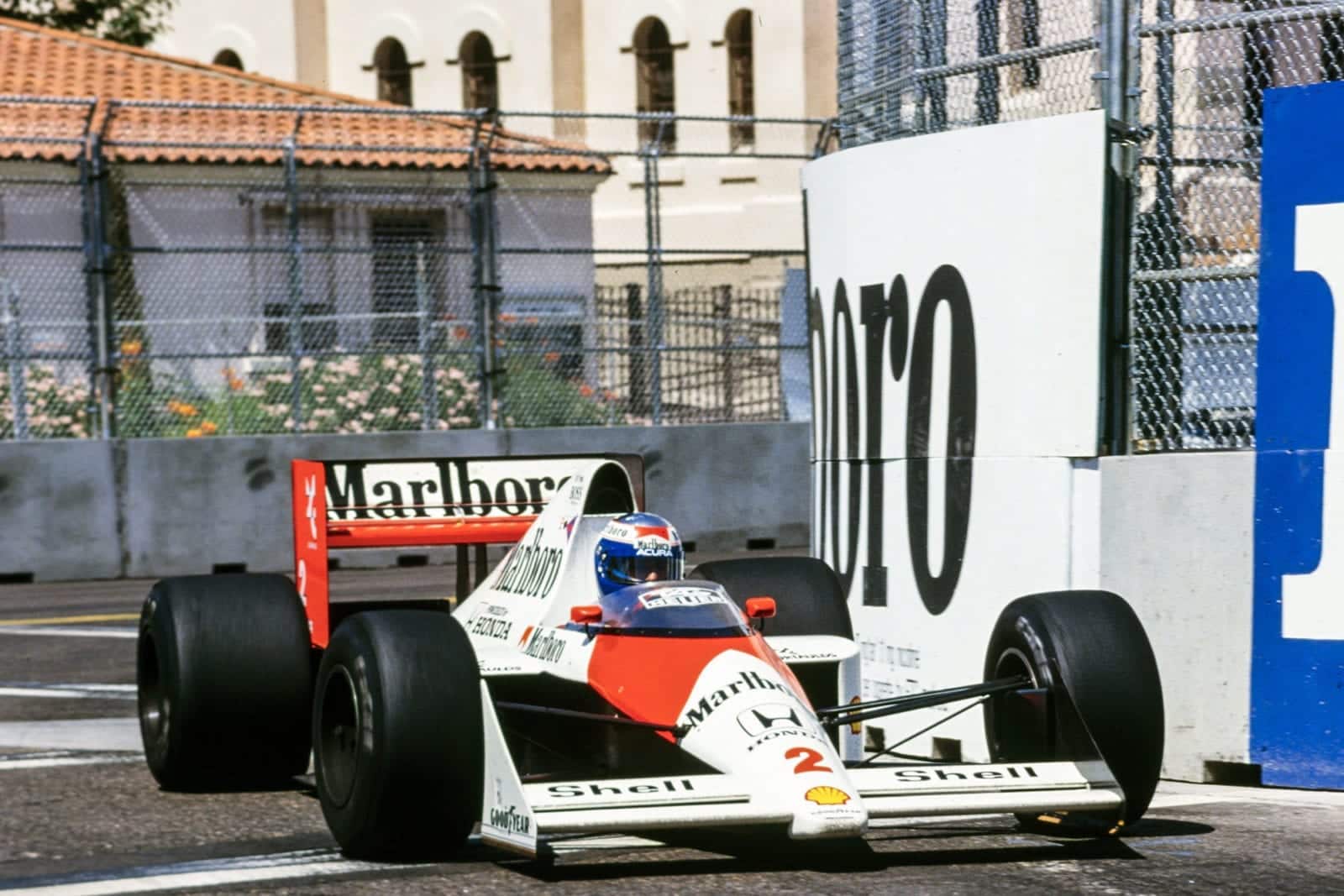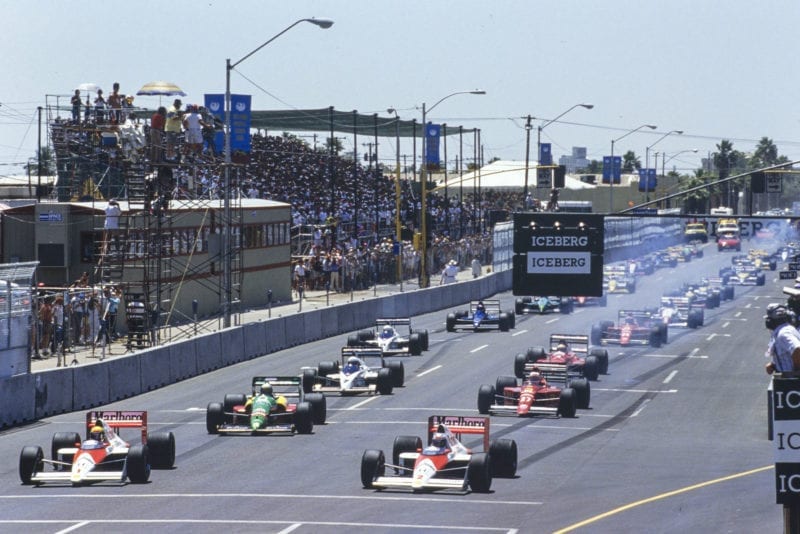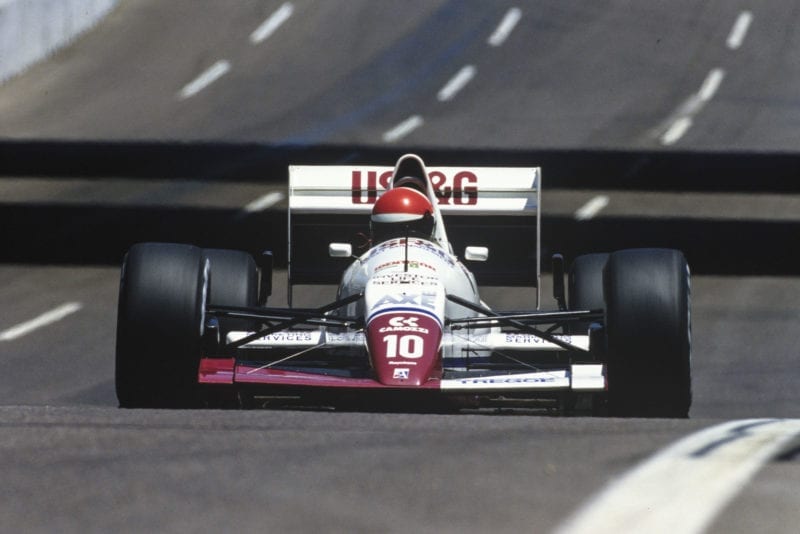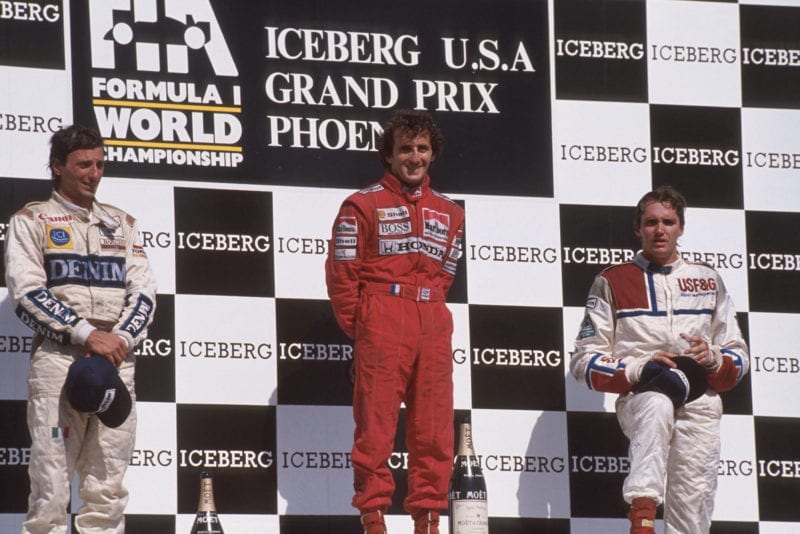1989 United States Grand Prix race report

Alain Prost took his first win of the season for McLaren
Motorsport Images
A sense of relief
Alain Prost was prominent in Phoenix for several reasons, but the one he preferred was having his name inscribed on the victor’s trophy after the heat-soaked event was stopped at the two-hour mark. By then, the Frenchman had covered 75 of the scheduled 80 laps of the 2.37-mile street track, but what made it an even better day for him was that faster team-mate Ayrton Senna had only managed 44 laps before his first mechanical failure racing a McLaren had forced him into retirement.
“I always felt I had a good chance here,” grinned Prost at the post-race Press conference, when he admitted that the result — his 36th GP victory — would have a significant impact on the rebuild his motivation is currently undergoing. “After Mexico I decided to play it safe with B tyres all round, and even before Ayrton began to run into trouble I felt I was in with a chance. I was sure my tyre combination would be an advantage late in the race.” Indeed, he actually led off the line, only to lose momentum as he hit a bump just as he shifted into fourth gear, the resultant blip on the rev-limiter momentarily cutting his Honda V10.
When Senna opened his customary lead to eight seconds after 18 laps, everyone was prepared for the inevitable, but then Prost began chipping away. It was 5.7 sec by lap 21, 6.3 sec a lap later, 4.02 sec by lap 32. The Brazilian had reversed his Mexican tyre set-up — this time he had Goodyear’s Cs on the left, Bs on the right — and felt perfectly able to control the pace. “That was the easiest race I’ve ever led,” he told former Newman-Haas Racing engineer Tyler Alexander afterwards. But by lap 33, the gap had shrunk dramatically, to 1.4 sec!
A misfire had set in, and as Prost swept by in the lead on lap 34, Senna blasted into the pits. The battery and ECU were changed, but though he charged back into the fray, he was in again shortly. This time the plugs were changed, but by lap 44 it was over. He had been so confident he had ordered the team to leave him on his original tyres, but ultimately it was to no avail.
Now in Formula One at present there is a deal of anti-Senna feeling, and it stems from his incredible run of success. At a pre-race conference, Bernie Ecclestone talked of several methods of handicapping successful teams. These included compulsory fuel or tyre stops to forcing a team which has won one of the preceding three races to make one stop. If it has won two, it stops twice. Three, thrice. It was ludicrous, and is hardly likely to get the necessary vote from Ron Dennis to conform with the unanimity clause of the Concorde Agreement. What was more ludicrous, however, was Bernie’s (tongue-in-cheek) suggestion that Senna himself should be handicapped, and the assertion that the Brazilian would have won in Mexico even in the Tyrrell. The gullible American local Press lapped it up, just as they were meant to. It all made good pre-race copy. Others, such as the reasoned Gordon Kirby, accepted it for what it was….
If FISA is seriously considering means of enlivening F1, it might look no further than introducing a rule forcing engine suppliers to equip a minimum of three teams after its first year of competition.
That said, there is no doubt — sorry Ayrton — that Senna’s retirement from the Phoenix race has enlivened the World Championship. “To beat him, you have to have no problems, and I had many problems here,” said Prost. And indeed he had. They came to a head on Saturday morning when he shunted his MP4/5 very heavily into the concrete wall in the double-apex left-hander Turn 13, which led on to the start/finish straight. It was the first time that he has wrecked a McLaren monocoque (as opposed to being in a McLaren monocoque which wrecked itself after suspension failure, as happened at Kyalami and Watkins Glen in 1980). He was forthright; it was his error. It left him a little detuned, and definitely second to Senna on the grid. It didn’t stop him on raceday, though.
The other reason that Prost’s name was on everyone’s lips was speculation that he might well quit McLaren at the end of the year, unable any longer to stomach the political situation. “This result will not influence my decision in any way,” he vowed, but already that decision has been put off from June to the autumn.
If he does quit, there is a good head of steam behind the idea of a Williams-Renault superteam, comprising Prost and Nigel Mansell, but where Prost came away with nine healthy points, the other two parties in that equation had good and bad news in Arizona. Williams was the luckier. Its bad fortune came in qualifying when, for some unaccountable reason, the gearshift linkages on both FW12Cs gave all sorts of trouble. “It is exactly as it was in Mexico,” said the perplexed Frank Williams, without having to add that it performed faultlessly there. The problem in Phoenix was exacerbated when the linkage tricked Patrese and Boutsen by selecting the wrong gears, and promptly broke the ratios all through Friday. By Saturday things were better on that front, but by then the team was a step out of synch and had to be satisfied with 14th and 16th on the grid.
Last year I may have entertained evil suspicions that perhaps Williams was losing its touch, but it proved in America that it is still worthy of consideration as a top contender. The cars still felt awful in Sunday’s warm-up, but Patrick Head guestimated new settings and — hey presto! — they were back in the ballpark. Patrese moved nicely through the field, overtaking some, benefiting elsewhere from others’ misfortune, to take his second consecutive second place. Boutsen would have been close too, but for a puncture which obliged a slow lap and a stop, and a seizing damper. He nonetheless fought back for sixth.
Mansell must now be eyeing the Williams’ newfound reliability with envy and not a small degree of interest. His good news, such as it was, came with fourth fastest qualifying lap in a Ferrari still to Mexican mechanical specification, and in the form of third place in the race, closing slightly on Prost, until lap 27. Then the bad news took over. The Ferrari’s alternator was overheating and in turn this affected the sensitive electro-hydraulic gearchange. A battery change didn’t really effect a cure, and, gearless, he rolled to a halt at the approach to Turn 13. Stepping from the Ferrari, he then had to roll it to safety himself, before the marshals craned it away.
On Friday the same marshals had tended Derek Warwick’s stricken Arrows after it had hit the wall there. They were keen, no question, but they failed to grasp that an F1 car will be tail heavy when a lifting web is slung just round its rollover hoop. Thus, despite the plaintive cries of a spectating Jackie “Bridgestone” Stewart, the A11 was hoisted up and promptly poured its remaining gearbox oil on to the track. It was cleaned up not, as one might expect, with the time-honoured cement dust, but a far more hi-tech product. Cat litter. Good old Kitty Whiskers cat litter, no less. And, dammit, it did the trick …
So far this season, Derek has outshone Eddie Cheever, the Briton being much happier in an understeering car. But this time Warwick tried a rash passing move on Andrea de Cesaris on lap eight, and ended his race there and then. It was than left to Phoenix’s own backyard boy to uphold USF&G Arrows honours. Now Eddie may not be up to much as a qualifier at times, but after he’d instructed his crew to change everything so that he had some front-end bite for the race, he truly rose to the occasion. From the start he sat on Patrese’s gearbox, and that’s virtually where he finished, a solid third in what was probably the best race of his career. Throughout, he looked a threat, but a minor fuel feed problem made his Cosworth hesitant, and in turn made him overtax his brakes. By the finish only the left rear was working properly, and narrowly avoiding a trip down the escape road finally convinced him to ease back. “I knew I had a second place car here today,” he admitted, “but that moment persuaded me it wasn’t worth throwing away an hour and fifty five minutes of hard work.”

Ayrton Senna took a fifth consecutive pole at Phoenix
Motorsport Images
Rial was probably the only other truly happy team in Phoenix, as Christian Danner kept his clog down throughout, despite poor balance and a broken exhaust, to grab the three points for an attritional fourth and keep Guenter Schmid’s team out of prequalifying its main car for at least another six months. Interestingly, de Cesaris finished in a similar position in last year’s US GP, in Detroit (pronounced Dee-trois if you’re important enough to visit a sweltering Phoenix wearing a white three-piece suit, as did one American columnist).
Behind the Rial, Johnny Herbert’s fifth place was the product of grit rather than speed. The Englishman hadn’t been on the pace all weekend, at a time when team-mate Sandro Nannini was hitting top form by qualifying the ageing and overweight Benetton B188 in a staggering third place. But where the Italian had the misfortune to hit the Turn 13 concrete hard in Sunday’s warm-up, and to lose an initial third in the race with a spin and then quit altogether on lap 11 when his neck muscles could no longer stand the strain, Herbert was in better shape to keep going.
His injured left ankle had a hard time with a wrongly-angled clutch pedal, his right foot was sore and blistered, and then fourth gear failed with 11 laps to go. Throw in a grabbing right front brake, and those two points counted for something. If you can’t run on the pace in a race like Phoenix, the next thing you do is aim to finish.
After Sandro’s qualifying performance, it wasn’t just Ford top brass which was left wondering how the lighter, more powerful B189 might have gone. . .
Gabriele Tarquini most certainly wasn’t in his usual happy frame of mind after the event, after coping with a misfire from lap two in the AGS, and then losing out to Boutsen literally within sight of the finish, but at least he was there, two laps down. Others were less lucky. Michele Alboreto went home firmly convinced he could have finished second. Phoenix gave him another chance to show that his is a far from spent talent, and having qualified ninth he was an easy eighth, comfortably ahead of Patrese, when his Tyrrell 018 lost all drive. “One minute she go, the next she doesn’t,” he shrugged.
Team-mate Jonathan Palmer had followed his nose too much in qualifying, and gone the wrong way on settings, but from 21st on the grid he hacked up to fourth with what turned out to be six laps to run. Then his Tyrrell stopped on the circuit with all the symptoms of fuel shortage. Ken Tyrrell had been the only entrant to stand firm against a motion that the race be shortened from 80 to 70 laps, and JP stopped on his 70th, but the likely explanation was fuel feed rather than shortage.

The race gets underway
Motorsport Images
Dallara, too, went away empty-handed. Once again Alex Caffi underlined his burgeoning talent (remember him hauling the Osella round Monaco in 1987?) by qualifying an excellent sixth and running as high as second to Prost before a stop for fresh Pirellis. He was getting his head down for a charge, after Patrese and Cheever, when he came up to lap his headstrong team-mate de Cesaris. Although Andrea had been the innocent party with Warwick, he had already sinned by clouting the wall on the grid formation lap (!) and on lap 53 he transgressed even more by shoving Caffi into the wall as he was being lapped. Observers just couldn’t believe it, and neither could team manager Patrizio Cantu …
Both Brabhams looked good for a while, especially when Stefano Modena climbed past Caffi and set out after Mansell in the early stages. His brake fluid began boiling after that, however, and a series of wild spins eventually prompted retirement. Brundle had qualified an excellent fifth (he was second only to Senna in free practice) but fluffed the first lap and lost places. Nevertheless, he was looking a strong points contender when his BT58 also boiled its brake fluid. It happened to him, however, during his tyre stop, as the heat sink from the hot discs took effect. There were thus no further points for the team under new managing director Teddy Mayer.
The brave Berger seemed on target for second at one stage, depriving Caffi of the position on lap 40. The Austrian had been upset by food poisoning during qualifying, and that didn’t help him acclimatise to the walled track, but he drove smoothly in the race even when Patrese and Cheever overwhelmed him, and only quit when he suffered similar alternator-rooted gearbox trouble as Mansell. By his demise on lap 62, however, his Imola-injured hands were so sore he was holding the wheel rim with his fingertips .. .
There have been few recent races where so many could have laid claim to second place, and the final two pretenders were Stefan Johansson and Ivan Capelli. Once again, the Swede pre-qualified the Moneytron Onyx, and once again he showed that his faith in Alan Jenkins’ design is justified. From 19th on the grid he charged on to the tail of the Capelli, Patrese, Cheever group as it fought over tenth place at the eight-lap mark, and was as high as seventh on lap 34 when a puncture slowed his chase of Eddie. The bumping as he toured pit-ward was to have its effect on lap 51, however. Back in seventh, and looking good for the points the team desperately needs to escape pre-qualifying, he was eliminated when the lower left front wishbone pulled out of the monocoque pick-up point.

Eddie Cheever finished an impressive 3rd for Arrows
Lack of testing has really hurt newly-renamed Leyton House Racing since it introduced the CG891 at Monaco. Unquestionably, it was right to get the new car racing as soon as possible, but the effect has been an up and down run ever since as the team learns about its new design. Capelli finally got his handling reasonably sorted to set 11th fastest grid time, and had eased ahead of Patrese for eighth, closing on Berger, when his transmission quit on lap 23. Mauricio Gugelmin, meanwhile, lined up 18th but was delayed when a rear brake caliper lost its bleed nipple. When he pitted for a replacement, he was subsequently black-flagged for adding brake fluid in contravention of the regulations.
The two new Minardis were both put out by high temperatures which eventually led to engine failures, and Philippe Alliot sensed a brake problem shortly before spinning the 12th-fastest Lola-Lamborghini and being unable to restart.
There was no such promise for the beleaguered Lotus team, for whom Phoenix was its 400th Grand Prix. Piquet lined up 22nd, Nakajima 23rd, the 101s robbed of an estimated 12% downforce by changes to the cooling system to cope with the anticipated ambient temperature above 100°F. The Japanese was hounding his Brazilian team leader for 12th when his throttle mechanism broke on lap 25, but Piquet finally looked on target for some much needed points as he lay seventh by lap 44. However, the plentiful spectator debris, in his case a plastic bag, affected the handling by wrapping itself over a front brake duct, and then blew into the sidepod. As his temperature climbed alarmingly, he had to stop.
He was also given a set of Cs and, thus freshly equipped, began to close on Herbert and Danner. Fifth place at least was possible, maybe even fourth, but even that he proved unable to manage. Already in disgrace with Camel for missing a function with its top brass on Friday evening, allegedly through sleeping through the ring of the telephone in his hotel room, he thumped the wall exiting Turn 13 on lap 52, and ended his race with broken suspension.

Prost can’t hide his delight at a first ’89 win
Motorsport Images
To Prost, then, yet another victory and the championship lead. To Senna, nothing more than a new record of 34 pole positions, and another fastest lap. Prost said his motivation was again stirring, and that had Senna won the race he would virtually have clinched the championship. Instead, it had been opened up again. For motor racing, if not for Ayrton, that was a major relief. DJT
